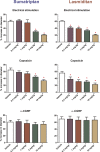Lasmiditan inhibits calcitonin gene-related peptide release in the rodent trigeminovascular system
- PMID: 31977930
- PMCID: PMC7170441
- DOI: 10.1097/j.pain.0000000000001801
Lasmiditan inhibits calcitonin gene-related peptide release in the rodent trigeminovascular system
Abstract
Migraine headache pathophysiology involves trigeminovascular system activation, calcitonin gene-related peptide (CGRP) release, and dysfunctional nociceptive transmission. Triptans are 5-HT1B/1D/(1F) receptor agonists that prejunctionally inhibit trigeminal CGRP release, but their vasoconstrictor properties limit their use in migraine patients with cardiovascular disease. By contrast, lasmiditan is a novel antimigraine and selective 5-HT1F receptor agonist devoid of vasoconstrictor properties. On this basis, this study has investigated the modulation of trigeminal CGRP release by lasmiditan. For this purpose, we have comparatively analysed the inhibition of several components of the trigeminovascular system induced by lasmiditan and sumatriptan through: ex vivo KCl-induced CGRP release from isolated dura mater, trigeminal ganglion, and trigeminal nucleus caudalis of mice; and in vivo dural vasodilation in the rat closed-cranial window model induced by endogenous (electrical stimulation and capsaicin) and exogenous CGRP. The ex vivo release of CGRP was similarly inhibited by sumatriptan and lasmiditan in all trigeminovascular system components. In vivo, intravenous (i.v.) lasmiditan or higher doses of sumatriptan significantly attenuated the vasodilatory responses to endogenous CGRP release, but not exogenous CGRP effects. These data suggest that lasmiditan prejunctionally inhibits CGRP release in peripheral and central trigeminal nerve terminals. Because lasmiditan is a lipophilic drug that crosses the blood-brain barrier, additional central sites of action remain to be determined.
Conflict of interest statement
A. Labastida-Ramírez and E. Rubio-Beltrán received travel support from Eli Lilly. C.M. Villalón received consultation fees from Eli Lilly. K.W. Johnson is employee of Eli Lilly. A. MaassenVanDenBrink received research grants and/or consultation fees from Amgen/Novartis, Eli Lilly, Teva, and ATI. The remaining authors declare no conflicts of interests.
Sponsorships or competing interests that may be relevant to content are disclosed at the end of this article.
Figures



References
-
- Ahn SK, Khalmuratova R, Jeon SY, Kim JP, Park JJ, Hur DG, Balaban CD. Colocalization of 5-HT1F receptor and calcitonin gene-related peptide in rat vestibular nuclei. Neurosci Lett 2009;465:151–6. - PubMed
-
- Amrutkar DV, Ploug KB, Hay-Schmidt A, Porreca F, Olesen J, Jansen-Olesen I. mRNA expression of 5-hydroxytryptamine 1B, 1D, and 1F receptors and their role in controlling the release of calcitonin gene-related peptide in the rat trigeminovascular system. PAIN 2012;153:830–8. - PubMed
-
- Beer MS, Heald MA, McAllister G, Stanton JA. Pharmacological characterisation of a cloned dog 5-HT1B receptor cell line. Eur J Pharmacol 1998;360:117–21. - PubMed
-
- Bhatt DK, Gupta S, Jansen-Olesen I, Andrews JS, Olesen J. NXN-188, a selective nNOS inhibitor and a 5-HT1B/1D receptor agonist, inhibits CGRP release in preclinical migraine models. Cephalalgia 2013;33:87–100. - PubMed
Publication types
MeSH terms
Substances
LinkOut - more resources
Full Text Sources
Research Materials

